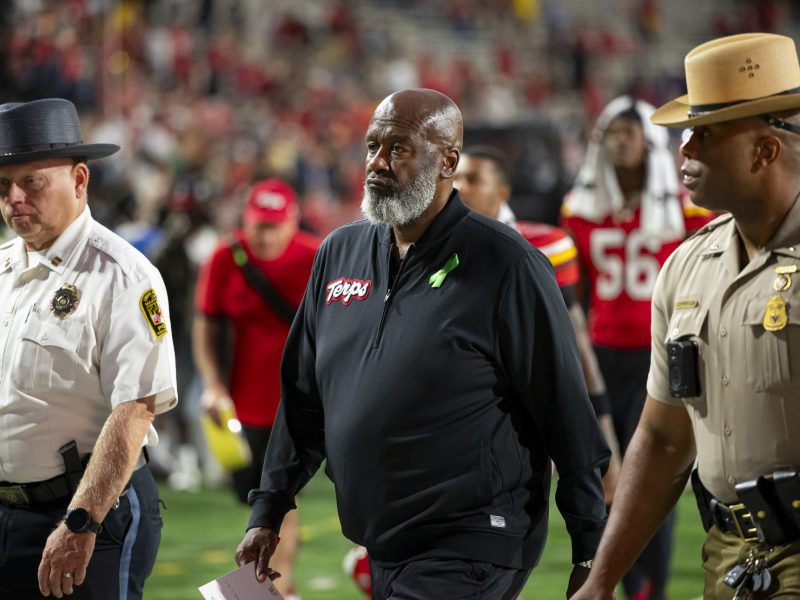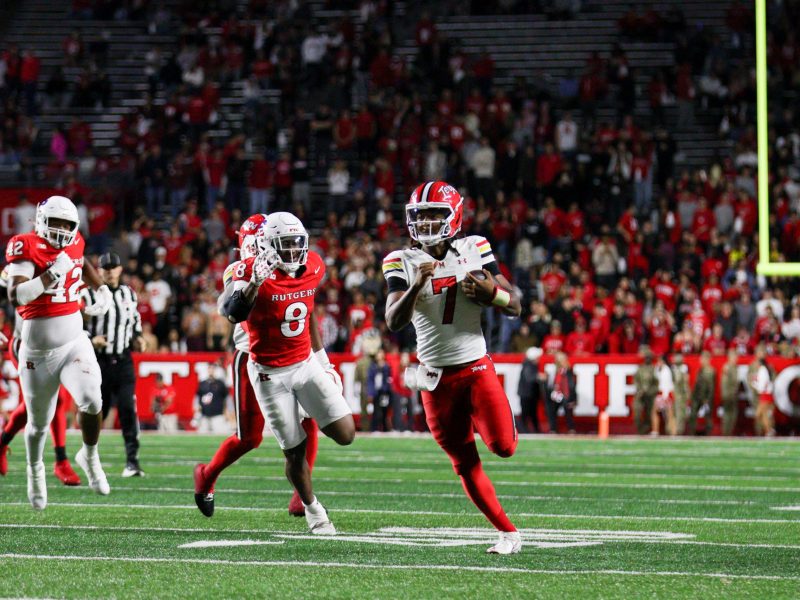Maryland football’s defensive line prepares for its first film-study of the day at 7 a.m. in the Jones-Hill House practice facility.
The Terps typically have two — one in the morning and another at 2 p.m. — in a cycle that repeats three times a week.
But it isn’t enough for Cam Rice.
The graduate student watches more film on a team-issued iPad alone every evening, typically on his couch or in his room. Rice met with The Diamondback to break down several of his plays this season.
Rice transferred from Ohio to Maryland this offseason and ranks second on the team with 14 hurries this season, according to Pro Football Focus.
“If you’re taking a test and you have the answers, you’re obviously going to do better,” Rice said. “That’s basically what film watching is like … it’s like a cheat sheet for the game.”
— Jake Kauderer (@jakekaudclips) October 30, 2025
Rice uses more power moves while on the defensive line’s interior since there’s such little space between him and the offensive lineman. On this play, he sees the guard overcommitting inside and swiftly pushes the gap between the guard and tackle. As a game progresses, Rice will track offensive lineman’s tendencies to rush the opposing quarterback.
[Maryland football mailbag: where Michael Locksley stands amid Terps’ struggles]
He went through that gap to record a sack against Washington after recognizing the guard was covering the area between the center and himself for much of the first half.
— Jake Kauderer (@jakekaudclips) October 30, 2025
He also pays attention to the offensive lineman’s eyes before snaps, which can reveal blocking assignments. If an opposing lineman is responsible for Rice, they’ll usually be facing him.
He listens to opponents’ communication, too. If they say a word that starts with the letter “R”, it typically means they’re shifting right, while “L” signals left. Other words signify protections, including max, where tight ends and running backs generally block.
“These guys talk so much and they’ll literally tell you what they’re doing — where they’re sliding, where they’re protecting to, and if you can pick up on that, it’s huge,” Rice said.
The in-game adjustments build off preparation. Maryland defensive line coach Corey Liuget sends out pass-rush reports each week with offensive lineman’s habits. Whether an opponent keeps their hands high, low or leave their chest open can dictate the Terps’ rushing strategy.
— Jake Kauderer (@jakekaudclips) October 30, 2025
Rice said Washington’s offensive lineman, using high hands, went all out for an “initial punch.” Rice rapidly used a club-swim move to apply pressure through a different gap between the center and guard.
[Zahir Mathis nearly quit football. Now he’s flourishing at Maryland.]
When advancing on opposing signal-callers, the 6’2’, 303-pound lineman’s background playing quarterback in middle and high school helps him. Rice said the experience gives him an extra sense of where a quarterback will scramble. It showed on his first sack of the year against Wisconsin.
— Jake Kauderer (@jakekaudclips) October 30, 2025
— Jake Kauderer (@jakekaudclips) October 30, 2025
Here, Rice is lined up on the edge and tasked with containing the quarterback. He is looking to grab the opposing offensive lineman’s elbow or wrist — a skill he said Maryland frequently practices — so he can manipulate their movement.
Containing the quarterback is a multi-step process. Rice avoids going too far into the backfield and focuses on staying wide.
“I like being versatile, I like to be able to play any position on the line,” Rice said. “You do have a little bit more space to work out [on the edge].”
Rice ranks second on the Terps in quarterback hits in his first season in College Park. Beyond his on-field impact, he has led in the film room for a young defensive line — one that has Maryland atop the Big Ten in sacks.
Rice wasn’t a big film observer growing up, only seriously starting when he began seeing the field more during his sophomore year at West Liberty University, a Division II college. Now, he considers himself an avid watcher and said it helps him steal a couple plays every game.
“It’s kind of like doing homework, but it’s fun,” Rice said.



